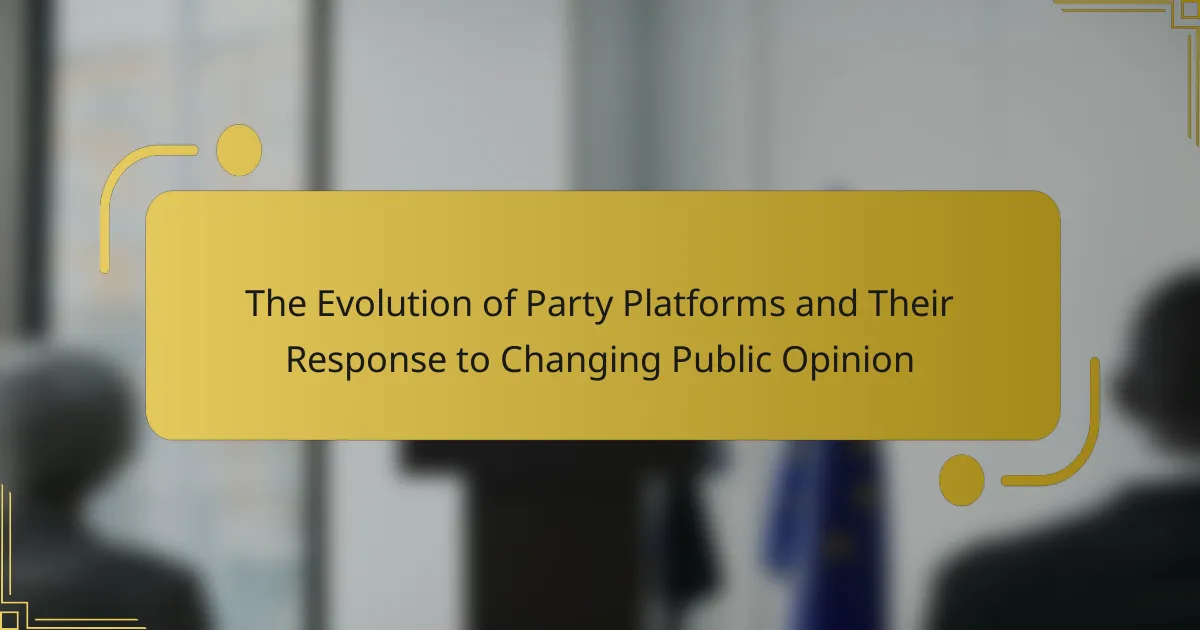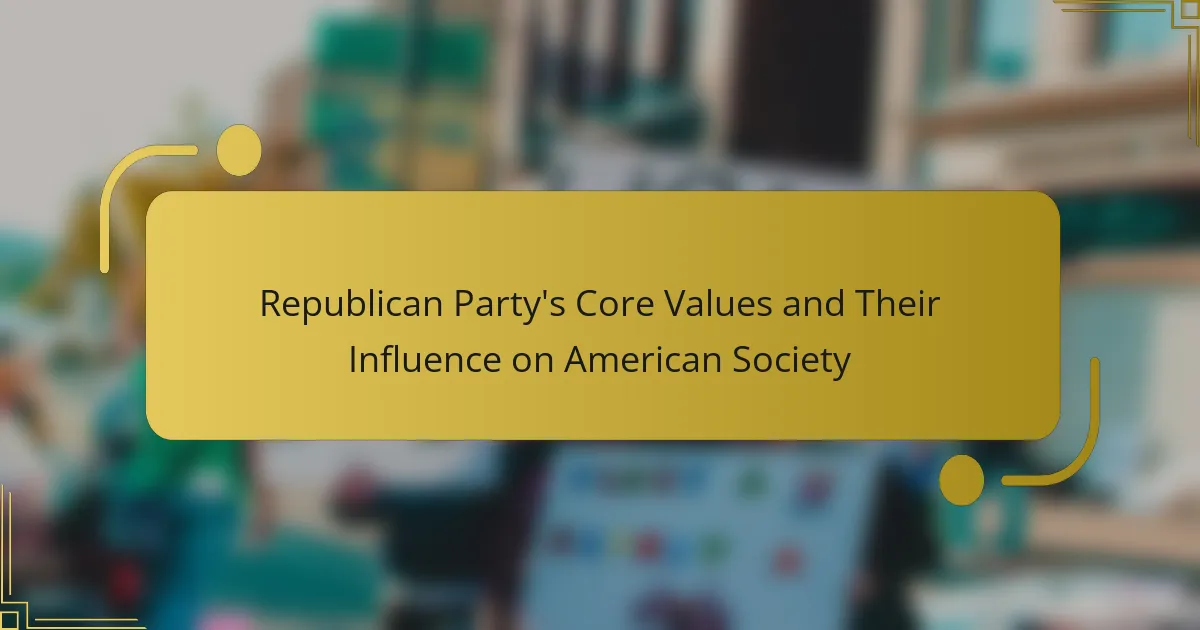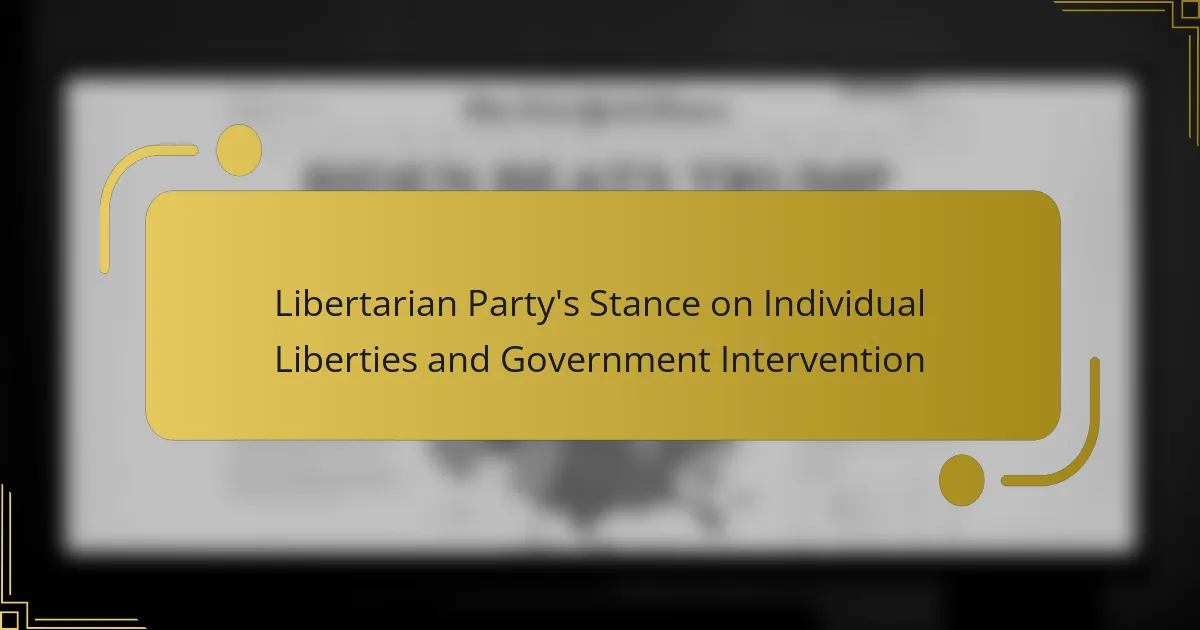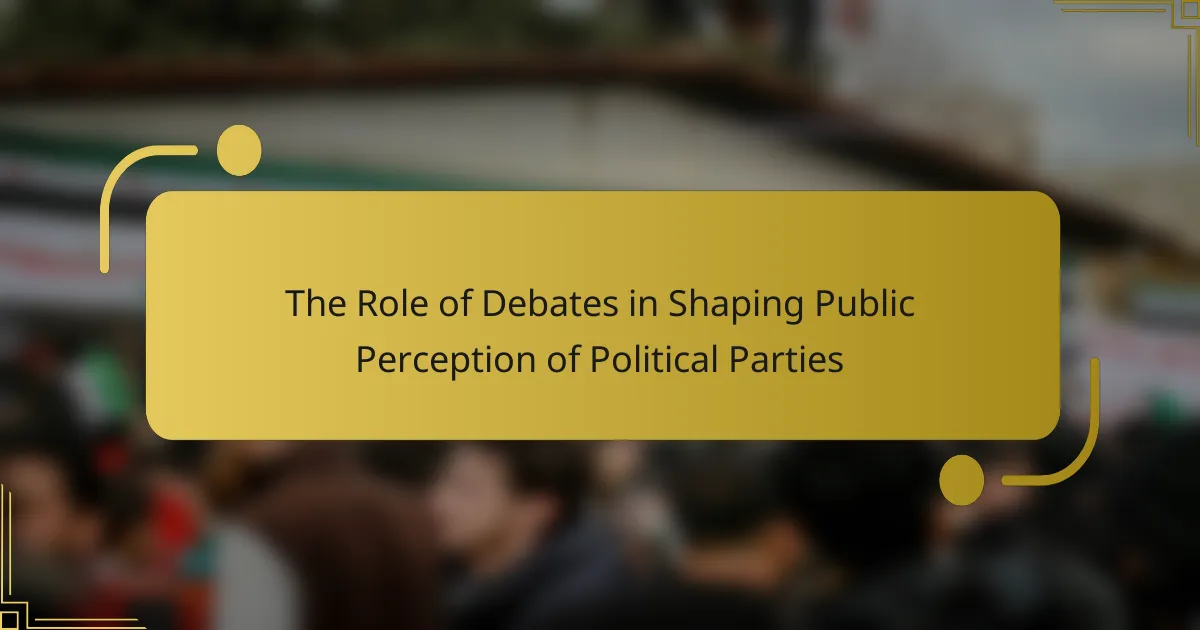Party platforms are formal documents that outline the beliefs, policies, and goals of political parties, guiding members and candidates during elections. This article examines the evolution of party platforms in response to changing public opinion, demographic shifts, and significant political events. It highlights how platforms help voters understand party positions on key issues and facilitate political discourse. Furthermore, the article discusses the various communication methods used by parties to convey changes in their platforms, emphasizing the importance of transparent communication in enhancing voter engagement and support. Historical examples illustrate how party platforms have adapted over time, reflecting societal needs and public concerns.
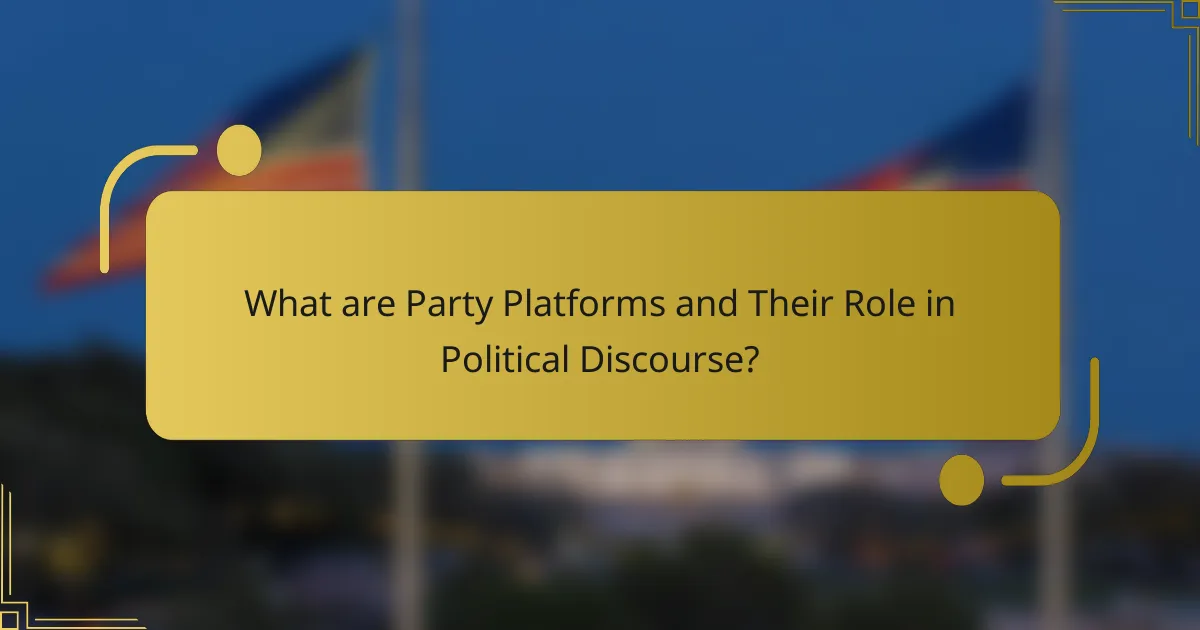
What are Party Platforms and Their Role in Political Discourse?
Party platforms are formal documents that outline a political party’s beliefs, policies, and goals. They serve as a guide for party members and candidates during elections. Party platforms help voters understand the party’s stance on various issues. They also facilitate political discourse by framing debates and discussions around key topics. Historically, platforms have evolved to reflect changing public opinions and societal needs. For example, the Democratic Party’s platform in 2020 emphasized climate change and social justice, aligning with growing public concern. The role of party platforms is crucial in shaping voter expectations and influencing legislative agendas.
How have party platforms historically influenced public opinion?
Party platforms have historically influenced public opinion by articulating the values and priorities of political parties. These platforms serve as a roadmap for party policies and governance. They shape voter perceptions and expectations during elections. For instance, the Democratic Party’s platform in 1932 emphasized economic recovery during the Great Depression. This resonated with a public desperate for change, leading to Franklin D. Roosevelt’s election. Similarly, the Republican Party’s platform in 1980 focused on tax cuts and deregulation, appealing to voters concerned about economic stagnation. This strategy contributed to Ronald Reagan’s victory. Overall, party platforms act as a crucial mechanism for aligning party agendas with public sentiment, impacting electoral outcomes significantly.
What key events have shaped the evolution of party platforms?
Key events that have shaped the evolution of party platforms include the Civil War, the Great Depression, and the Civil Rights Movement. The Civil War led to the emergence of distinct party identities, particularly between the Republican and Democratic parties. The Great Depression prompted significant shifts in economic policies, resulting in the New Deal coalition under Franklin D. Roosevelt. The Civil Rights Movement forced both parties to address issues of race and equality, influencing their platforms significantly. These events have consistently reflected and responded to changing public opinion, shaping the political landscape in the United States.
How do party platforms reflect the values of their constituents?
Party platforms reflect the values of their constituents by articulating shared beliefs and priorities. These platforms serve as official statements that outline the party’s stance on key issues. They are developed through extensive surveys and feedback from party members and the public. This process ensures that the platforms align with the constituents’ needs and desires. For example, the Democratic Party’s platform often emphasizes social justice and healthcare access, reflecting the values of its diverse voter base. Conversely, the Republican Party typically focuses on economic growth and individual freedoms, mirroring the priorities of its supporters. Historical trends show that platforms evolve in response to changing public opinion, demonstrating the dynamic relationship between constituents and their political parties.
Why is it important for party platforms to adapt to changing public opinion?
Party platforms must adapt to changing public opinion to remain relevant and effective. This adaptation helps parties align their policies with the values and concerns of the electorate. When platforms reflect public sentiment, they enhance voter engagement and support. Historical examples show that parties that ignore public opinion risk losing elections. For instance, the Democratic Party’s shift on civil rights in the 1960s helped gain support from minority voters. Adapting to public opinion also allows parties to address emerging issues, such as climate change. Ultimately, responsiveness to public sentiment fosters trust and credibility in political institutions.
What are the consequences of outdated party platforms?
Outdated party platforms can lead to decreased voter engagement. When platforms do not reflect current public concerns, parties risk alienating constituents. This disconnection can result in lower voter turnout during elections. Additionally, outdated platforms may hinder a party’s ability to attract new members. A lack of relevance can diminish a party’s influence in political discourse. Historical examples show that parties failing to adapt often lose electoral support. For instance, the Democratic Party struggled in the 1980s due to outdated positions on economic issues. Consequently, parties must continuously update their platforms to remain viable and competitive.
How can party platforms effectively respond to emerging social issues?
Party platforms can effectively respond to emerging social issues by actively engaging with constituents and adapting their policies. This involves conducting regular surveys to gauge public opinion on pressing topics. Additionally, platforms should incorporate diverse voices from various demographics to ensure inclusivity. Utilizing data analytics can help identify trends and shifts in public sentiment.
Furthermore, timely communication through social media can raise awareness and foster dialogue. For instance, platforms like Twitter and Facebook allow for immediate feedback and discussion. Collaborating with grassroots organizations can also enhance credibility and outreach.
Research shows that parties that adapt quickly to social changes tend to maintain voter support. A study by the Pew Research Center indicates that responsiveness to social issues can significantly influence electoral outcomes. Thus, a proactive approach is essential for party platforms to remain relevant and effective.
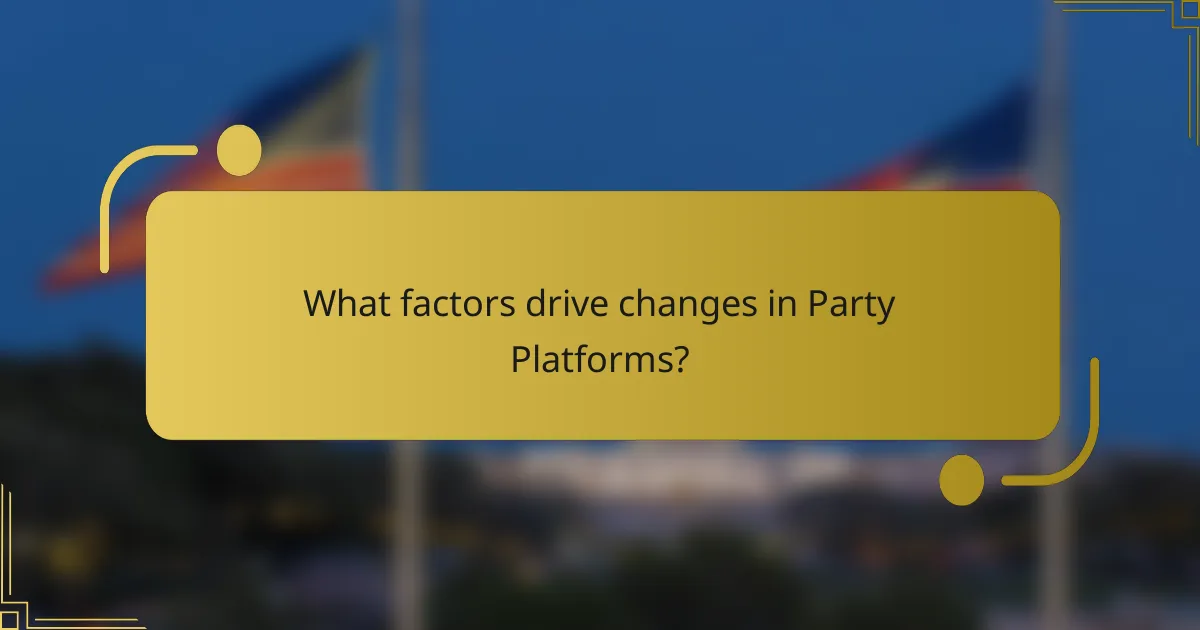
What factors drive changes in Party Platforms?
Changes in party platforms are driven by shifts in public opinion, demographic changes, and political events. Public opinion influences party priorities and policies. For example, as social issues gain traction, parties may adapt their platforms to align with voter sentiments. Demographic changes, such as age and ethnicity, also impact party strategies. Political events, like elections or crises, can prompt parties to reevaluate their positions. Historical examples include the Civil Rights Movement influencing Democratic Party policies in the 1960s. Additionally, party leadership changes can lead to shifts in ideology and focus. These factors collectively shape how parties evolve over time.
How does public opinion polling impact party platform development?
Public opinion polling significantly influences party platform development. Polls provide data on voter preferences and concerns. This information helps parties align their platforms with public sentiment. For instance, in the 2016 U.S. presidential election, polling indicated strong support for healthcare reform. As a result, candidates emphasized healthcare in their platforms. Additionally, polling can reveal emerging issues that parties may need to address. When polls show shifts in public opinion, parties often adjust their platforms accordingly. Historical examples include the Democratic Party’s shift towards environmental issues in response to growing public concern. Overall, public opinion polling serves as a critical tool for parties to remain relevant and responsive to voters.
What methodologies are used to gauge public sentiment?
Surveys and polls are primary methodologies used to gauge public sentiment. These tools collect data from a sample of the population to understand opinions and attitudes. Surveys often employ structured questionnaires to quantify responses. Polls may focus on specific questions to capture immediate public opinion trends. Social media analysis is another methodology that examines online interactions and sentiments. Natural language processing techniques analyze text data for sentiment analysis. Focus groups provide qualitative insights through discussions among selected participants. Each method has its strengths in capturing different aspects of public sentiment. For example, surveys can provide statistically significant data, while focus groups offer deeper insights into motivations and feelings.
How do political parties interpret polling data in their platform revisions?
Political parties interpret polling data by analyzing public opinion trends. They assess which issues resonate with voters. This analysis informs decisions on platform revisions. Parties often adjust their positions to align with popular sentiments. For example, a rise in support for climate action may prompt a party to enhance its environmental policies. Historical data shows that parties frequently change their platforms based on polling results. In the 2008 U.S. presidential election, Barack Obama’s campaign shifted focus to healthcare reform in response to polling data indicating it was a priority for voters. Such adaptations help parties remain relevant and competitive.
What role do social movements play in shaping party platforms?
Social movements significantly influence the development of party platforms. They raise awareness about specific issues and mobilize public support. This pressure often compels political parties to adopt new policies. For instance, the civil rights movement led to major shifts in the Democratic Party’s platform in the 1960s. Similarly, environmental movements have pushed parties to prioritize climate change in their agendas. Social movements also provide a grassroots base for parties, enhancing their legitimacy. Research indicates that parties responding to social movements can gain electoral advantages. This dynamic showcases the interplay between societal change and political adaptation.
Which recent social movements have significantly influenced party platforms?
Recent social movements that have significantly influenced party platforms include the Black Lives Matter movement, the Me Too movement, and climate change activism. The Black Lives Matter movement has pushed for racial justice and police reform, prompting many political parties to adopt more progressive stances on these issues. The Me Too movement has raised awareness about [censured] harassment and gender equality, leading parties to prioritize women’s rights in their platforms. Climate change activism has resulted in a stronger emphasis on environmental policies and sustainability within party agendas. These movements have reshaped public discourse and compelled parties to align their policies with the demands of their constituents.
How do parties integrate the demands of social movements into their platforms?
Parties integrate the demands of social movements into their platforms by adapting their policies and messaging. They often conduct research to understand the core issues raised by these movements. This involves analyzing public sentiment and the specific demands of social movements. Parties may hold discussions with movement leaders to gain insights. Incorporating these demands can enhance their appeal to a broader voter base. For instance, the Democratic Party has embraced climate change initiatives due to pressure from environmental movements. Similarly, the Republican Party has adjusted its stance on social issues in response to grassroots activism. This integration helps parties remain relevant and responsive to changing public opinion.

How do Political Parties Communicate Changes in Their Platforms?
Political parties communicate changes in their platforms through various channels. These channels include press releases, social media, and public speeches. Each method allows parties to reach different audiences effectively. Press releases provide formal announcements to the media. Social media platforms enable real-time engagement with the public. Public speeches allow party leaders to articulate changes directly.
Additionally, party websites serve as a central hub for information. They often feature detailed explanations of platform updates. Surveys and polls can also be utilized to gauge public reaction. Historical examples include the Democratic Party’s shift on healthcare in 2008. They used multiple communication strategies to clarify their stance.
Research indicates that effective communication increases voter understanding and support. Studies show that transparent communication correlates with higher voter engagement. Thus, political parties strategically use various platforms to communicate their evolving positions clearly.
What strategies do parties use to announce platform changes?
Parties announce platform changes through various strategies. They often utilize press releases to communicate official updates. Social media platforms serve as a direct channel for real-time announcements. Town hall meetings allow for personal interaction and immediate feedback from constituents. Additionally, parties may host press conferences to elaborate on significant changes. Engaging in targeted advertising helps to reach specific demographics more effectively. Surveys and focus groups can gauge public response to proposed changes before announcements. These strategies have been used historically, as seen in the 2016 U.S. presidential election when parties adapted their platforms based on voter sentiment.
How do media channels affect the dissemination of party platform updates?
Media channels significantly influence the dissemination of party platform updates. They determine how quickly and widely information reaches the public. Traditional media, like newspapers and television, provide extensive coverage but may filter information through editorial biases. Digital media, including social media platforms, allow for rapid sharing and direct engagement with voters. Research indicates that social media can amplify messages, with platforms like Twitter and Facebook facilitating real-time updates and discussions. According to a Pew Research Center study, 53% of Americans report getting news from social media, highlighting its role in shaping public perception of party platforms. Consequently, the choice of media channel affects not only the speed of information dissemination but also the narrative surrounding party updates.
What role does social media play in platform communication?
Social media serves as a critical tool for platform communication. It enables direct interaction between political parties and the public. Through platforms like Twitter and Facebook, parties disseminate their messages quickly. This fosters real-time engagement and feedback from constituents. Research shows that 69% of adults in the U.S. use social media, amplifying its influence. Social media also allows parties to tailor their messages to specific demographics. This targeted approach enhances voter outreach and mobilization efforts. Additionally, social media provides a space for grassroots movements to gain visibility. Overall, social media has transformed how parties communicate and respond to public opinion.
How do voters respond to changes in party platforms?
Voters respond to changes in party platforms by adjusting their support based on alignment with their values. When parties shift their positions, voters evaluate these changes against their beliefs. Research indicates that significant platform changes can lead to shifts in voter allegiance. For instance, a Pew Research Center study found that 52% of voters are influenced by party platform changes. Voters may feel more inclined to support a party that reflects their current priorities. Conversely, if a party’s platform diverges from voter expectations, it can result in decreased support. Historical examples show that major platform shifts can lead to electoral gains or losses. Therefore, party platforms play a crucial role in shaping voter behavior and electoral outcomes.
What factors influence voter support for revised platforms?
Voter support for revised platforms is influenced by several key factors. These factors include public opinion trends, economic conditions, and social issues. Public opinion trends reflect the changing priorities and values of the electorate. Economic conditions, such as unemployment rates and inflation, directly affect voter perceptions of party platforms. Social issues, including healthcare and education, also play a critical role in shaping voter preferences. Furthermore, the effectiveness of a party’s communication strategy can enhance or diminish support. Historical examples show that platforms aligned with current public sentiment tend to gain more traction. For instance, during economic downturns, parties emphasizing job creation often see increased voter backing.
How can misalignment between platforms and public opinion affect election outcomes?
Misalignment between platforms and public opinion can significantly impact election outcomes. When political party platforms do not reflect the views of the electorate, voter disengagement can occur. A study by Pew Research Center found that 60% of voters feel disconnected from political parties that do not align with their beliefs. This disconnect can lead to lower voter turnout, as individuals may feel their vote does not matter. Additionally, candidates who ignore public sentiment risk losing critical support. Historical examples, such as the 2016 U.S. presidential election, show that candidates who adapted their platforms to align with public concerns gained traction. Ultimately, platforms that resonate with public opinion can drive higher engagement and influence election results.
What best practices should parties follow when updating their platforms?
Parties should follow several best practices when updating their platforms. First, they must conduct thorough research on current public opinion. Surveys and focus groups can provide valuable insights into voter priorities. Second, parties should ensure that updates reflect core values and principles. This maintains consistency and trust with constituents. Third, parties must engage stakeholders in the revision process. Involving party members and community leaders can foster broader support. Fourth, transparency is crucial. Parties should communicate changes clearly to the public. This builds credibility and encourages dialogue. Finally, parties should evaluate the impact of updates regularly. Monitoring public response helps refine future platform revisions. These practices are essential for staying relevant and responsive to voter needs.
How can parties ensure their platforms remain relevant and inclusive?
Parties can ensure their platforms remain relevant and inclusive by actively engaging with diverse communities. This engagement helps to identify the needs and concerns of various demographic groups. Regularly updating policy positions based on feedback is essential. For instance, incorporating input from underrepresented groups can enhance platform inclusivity.
Conducting surveys and focus groups allows parties to gauge public sentiment effectively. Research shows that parties with inclusive platforms tend to attract a broader voter base. A study by the Pew Research Center indicates that inclusive policies can increase voter turnout by up to 15%.
Additionally, leveraging social media platforms facilitates real-time communication with constituents. This approach enables parties to adapt quickly to changing public opinions. Overall, continuous dialogue and adaptability are key strategies for maintaining relevance and inclusivity.
What are common pitfalls to avoid when revising party platforms?
Common pitfalls to avoid when revising party platforms include neglecting grassroots input. Failing to incorporate feedback from party members can alienate the base. Another pitfall is overcomplicating the language of the platform. Clear, accessible language is crucial for voter understanding. Ignoring data and trends can also be detrimental. Research shows that platforms aligned with public sentiment are more successful. Additionally, not addressing past failures can lead to repeated mistakes. Historical context is essential for learning and growth. Lastly, being overly reactive to current events may result in inconsistencies. A well-thought-out, stable platform is necessary for long-term success.
The main entity of this article is party platforms, which are formal documents outlining political parties’ beliefs, policies, and goals. The article examines how party platforms have evolved in response to changing public opinion, highlighting their role in shaping political discourse and influencing electoral outcomes. Key factors driving changes in platforms include public sentiment, demographic shifts, and significant historical events. Additionally, the article discusses the importance of adapting platforms to remain relevant and the methodologies used to gauge public opinion, including surveys and social media analysis. It also addresses the consequences of outdated platforms and best practices for ensuring inclusivity and relevance in political messaging.
